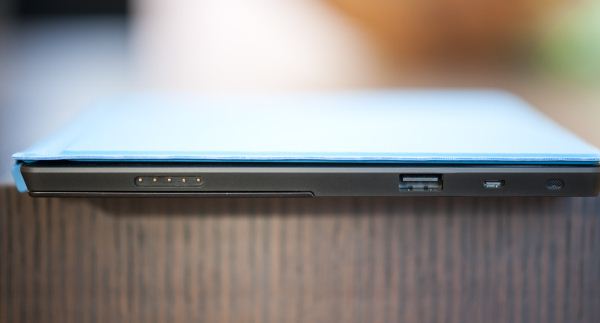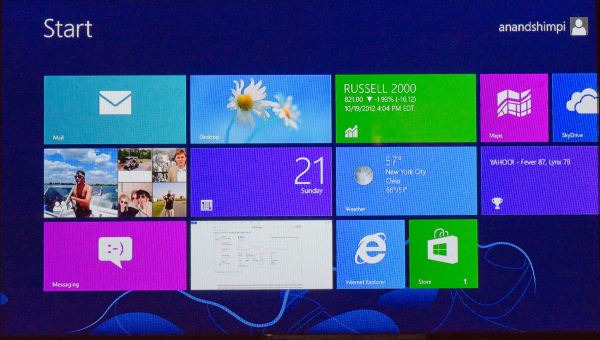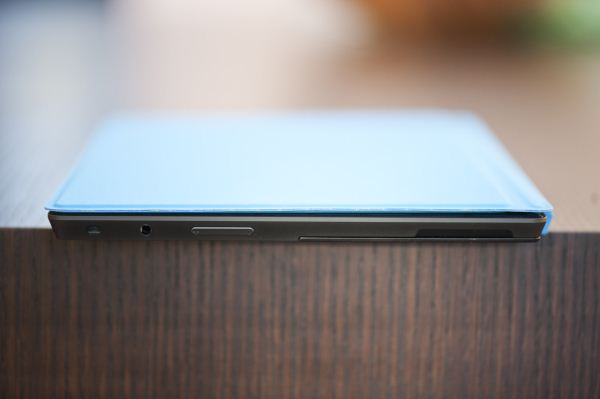Microsoft Surface Review
by Anand Lal Shimpi on October 23, 2012 9:01 PM EST- Posted in
- Tablets
- Microsoft
- Mobile
- Surface
- Windows RT
A Plethora of Ports and Storage Options
One area where Surface is a significant departure from the iPad is in its IO and expansion. The iPad features a single dock (and soon to be Lightning) connector, while Surface looks more like a laptop (or Android tablet) when it comes to IO.
There’s no port for syncing, you get content onto Surface via WiFi or a more traditional method. Surface has a single USB 2.0 port on the right side of the device. You can plug almost anything you want into this port, including USB storage devices of course. Behind the kickstand is a single microSD card slot, giving you another option for expansion.
On the left edge of the device there’s a micro-HDMI out port that can be paired with a Microsoft made VGA or HDMI dongle (both dongles have a 22-degree connector on them to mate flush with Surface). I tested HDMI output with Microsoft's dongle and unfortunately the result wasn't very good. The 1080p output had a lot of issues with scaling quality (as you can see from the shot below) and there was a lot of tearing on the screen with a big impact on UI frame rate. I reached out to Microsoft for an explanation but have yet to hear anything.
Finally there’s a standard 1/8” headphone jack along the top of the device.
Power delivery comes via a custom magnetic connector along the lower right side of Surface.
Given that the internal storage is an eMMC solution, performance from the microSD slot with a good card should be fairly comparable. In practice I could read and write a large sequential file at roughly 10.5 MB/s using a SanDisk microSD card.
Copying from a fast USB stick to Surface’s internal storage gave me transfer rates closer to 17MB/s. There are a few vendors for Windows 8/RT eMMC devices, I’ll be paying close attention over the coming weeks to figure out who makes the best. I know Microsoft and Intel (among others) have been playing close attention to the eMMC providers with hopes of weeding out those that deliver honestly unacceptable performance.
While doing background file IO I didn’t notice any of the stalling/pausing that we’ve seen on some of the more recent Android tablets.
Update: Many have asked about how much storage is taken up by the Windows + Office 2013 installs. The screenshot below shows the directory size for both C:\Windows and C:\Program Files, the latter is where the Office15 install files are included (and yes winword.exe is still the Word executable).
You're looking at roughly 6.47GB for Windows RT and then another 830MB for Office for a grand total of around 7.3GB.
USB Compatibility
Microsoft is particularly proud of its single USB 2.0 port on Surface. Although USB ports have been featured on several Android tablets, their support was typically limited to flash drives, keyboards and mice. With Windows RT, Microsoft wants to bring more of the traditional Windows experience to tablets. Had Surface been x86 based, you would be able to plug in virtually any USB peripheral and it would just work. As the first version of Surface is based on an ARM SoC, driver support is a little more limited but still pretty decent.
USB drives obviously work as you’d expect them to. Even SATA to USB adapters worked fine when plugged into Surface. Other smartphones and tablets also worked, although their level of support varied. For example, you can plug in the iPhone 5 and have it come up as a supported device for moving pictures to/from. However USB tethering is not supported by the class driver included in Windows RT. You can even plug an iPad into Surface and get the same level of support.
Printer support is pretty decent, although the Epson Workforce 910 I tried didn’t actually have specific driver support under RT. Although development for the desktop side of Windows is limited, manufacturers can supply Windows RT drivers to enable support for some more obscure devices. Unfortunately when it comes to those devices you’ll have to play the waiting game as there’s simply not a lot of third party Windows RT drivers available for download today.






_575px.png)








235 Comments
View All Comments
Shadowmaster625 - Wednesday, October 24, 2012 - link
Doesnt it bother you that simply typing a vanilla document in Office uses so much cpu power. You think they are ever going to fix that? What happens when you give it access to much more cpu resources? Will it simply consume it all?andrewaggb - Wednesday, October 24, 2012 - link
Both Anand and Vivek said it keeps up though, which is the main thing I think. And these are guys who type for a living. Really it drives home that anything slower than tegra 3 wouldn't cut it and tegra 3 is barely fast enough.As for what happens when you give it more cpu, how does word run on your current desktop? On my first gen core i7 laptop (dual core), I can get word up to 4% cpu in task mgr by key bashing.
I'd be very interested in seeing what battery life and video performance an atom based tablet gets.
robmuld - Wednesday, October 24, 2012 - link
The choice of 16:9 for the display just tells me Microsoft will never get itN4g4rok - Wednesday, October 24, 2012 - link
Have you looked at the Pro version spec sheet?WP7Mango - Wednesday, October 24, 2012 - link
Actually, Microsoft DO get it. There are 3 reasons why 16:9 is preferable -1. It allows for the Windows 8 / RT multitasking feature - two apps snapped side by side, with one app taking up a thin column whilst the other app taking up a larger portion. These can be swapped round just by dragging the seperator between them. Even the desktop can be snapped with a metro app this way. It's an elegant solution to multitasking on a tablet, and a feature that the iPad doesn't have.
2. It's the ideal size for watching movies whilst minimising black borders.
3. The extra horizonal screen space gives you more flexibility in terms of app UI capabilities.
ET - Wednesday, October 24, 2012 - link
I think it's a pity that Microsoft doesn't allow running .NET apps on the desktop interface. That would have made Window RT comparable to Windows 8 and allowed using the Surface as a full PC, with a decent choice of software already available.jamawass - Wednesday, October 24, 2012 - link
Interesting review. Does the usb port support cameras? Can pictures be transferred from a camera to the surface as on a desktop?WP7Mango - Wednesday, October 24, 2012 - link
Yes, the USB port does support cameras. Yes, pictures can be transferred from a camera to the Surface just like you can on a desktop PC.karasaj - Wednesday, October 24, 2012 - link
I don't know if you're still answering questions Anand (or any staff) but do you think Surface RT would suffice for a university student who just needs to rapidly type on Microsoft office for ~50 minutes without it feeling sluggish at all? That and streaming netflix are probably all that I need to do with Surface, if I can do that, then I'd pay for surface over an ultrabook (i.e. vizio ct14-a0) for the portability and battery life.B3an - Thursday, October 25, 2012 - link
I think Surface would be the best option for that kind of stuff. It's perfectly suited for it. My brother is at uni and wants the same kind of thing, and he's getting a Surface.